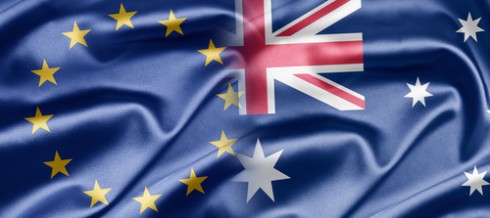By Jane Drake-Brockman
Director, EU Centre for Global Affairs, Institute for International Trade, The University of Adelaide
Vice-President, Australian Services Roundtable
The narrative on commercial relations between Australia and the EU has traditionally been about agriculture. That was largely yesterday’s story. In retelling it, we risk remaining blind to current Australian business realities and ignore new emerging public policy priorities. The fact is today’s big bilateral trade and investment stories are all about services.
The first story is that balance of payments data for 2015-16 show direct services exports accounting for nearly 40% of Australian exports to the 28 Member States of the EU. This is a remarkable outcome, given that services average a mere 22% in total Australian exports.
What this means is that when it comes to Australia’s commercial relations with the EU, the services industries have nearly double their average importance relative to other sectors.
From an Australian perspective this suggests that they deserve perhaps twice as much public policy attention.
The second story is that the EU is generally Australia’s top services export market. In 2015-16, Australian services providers sold $10.5 billion to clients in the EU. Probably half of this is tourism – but Australian professional, business and technical services providers are also big contributors to this strong export performance.
The EU is also a services growth market, though it has not been growing as fast as China which surged ahead to reach $10.7 billion in 2015-16, due to rapid growth in Chinese tourists and sustained growth in Chinese student numbers. In China’s case, services account for only 12% of Australia’s exports.
A third aspect of this story is that the EU is also Australia’s largest source of services imports, meaning that services figure relatively much more importantly in the overall trading relationship with the EU than on average with other trading partners. Australia’s total bilateral trade in services with the EU has grown on average more than 9% p.a. over the last decade.
The fourth strand to this positive bilateral story on services is that it contrasts significantly with the recent evolution of bilateral merchandise trade.
Eurostat data shows that during the period 2010-2014, Australia’s merchandise exports to the EU (chiefly primary products including crude materials, mineral fuels, lubricants and related materials which account for 44% of the total) fell by an average of 7% p.a.
Meanwhile Australia’s merchandise imports from the EU (chiefly manufactures including machinery, transport equipment and chemical products which account for 65% of the total) increased by 2% p.a.
Over this same period, Australia’s imports of services from the EU increased by 9% p.a, but very importantly Australia’s services exports to the EU also increased by an average of 3% p.a.
The final piece in the story line is that 2015-16 data show the EU to have become Australia’s largest destination for outward foreign direct investment (FDI). And the EU ranks as Australia’s largest source of inward FDI stock in Australia, with an approximate 25% share. And to which industries is that EU investment directed? According to FDI Markets data, Australia’s top 3 recipient industry sectors of inward FDI from the EU are business services, software and IT services and financial services.
The simple fact is that the rise of knowledge-based activities and the growing importance of intangible assets, together with increasing digitalisation and the enhanced role of services inputs in manufacturing and agricultural, all lead to an increasing importance of services both in Europe and in Australia.
The story comes to its climax in the proposed bilateral trade negotiations between Australia and the EU. The EU is by far the biggest exporter and importer of services in the world – and the world’s biggest investor in the services sector. The proposed negotiations offer a potential opportunity for Australia to leverage its own strengths in this sector.
Today’s big bilateral business opportunities lie in collaborative innovation and development of the modern services economy: in intensifying an exchange in data-related services inputs to business processes that can drive productivity gains across all industry sectors.
Might the story change after Brexit? Possibly yes.
The UK represents almost half of EU services imports from Australia (four times more than Germany, the second largest services trading partner after the UK) and more than a third of EU exports of services to Australia (twice as much as Germany). The UK is the source of more than half of EU investment in Australia and is the destination for two-thirds of Australian outward FDI in the EU. The services and investment story is strongly UK-oriented.
Meanwhile, in merchandise trade, the UK takes a much higher share of EU imports from Australia than its weight in terms of GDP, while its share in EU exports to Australia is merely in line with its GDP weight. Brexit would seem unlikely to reduce EU27 offensive interests in a trade deal with Australia, and it might boost Australia’s market access interests in the EU27.
A bilateral negotiation with the EU27 risks being more about merchandise trade than a negotiation with the EU28 would be. Let’s hope we don’t get stuck in yesterday’s narrative.

